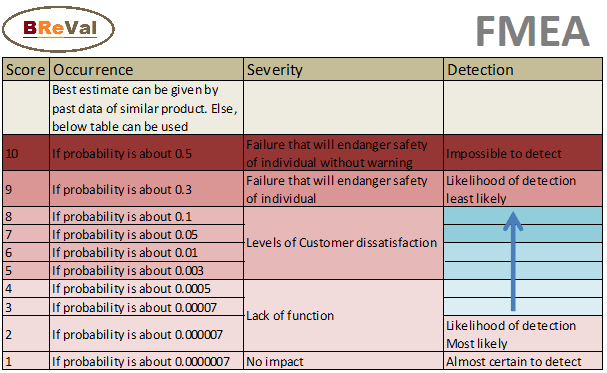Failure mode & effect Analysis (FMEA)
An Engineering technique for system reliability improvement.
FMEA refers to a structural tool to identify potential failures at component level, the causes of these failures, and effect these failures will have on the operation of the system.
Steps:
1. Determine product & gather associated data.
2. List all the possible failure modes. This is a very important step, and should be given enough time and resources. For each failure ask how, where, when and why.
3. Calculate RPN (Risk priority No.)
4. Put all in descending order of RPN nos.
5. Development of action plan which the team deem most significant.
6. Failure with high Severity no. should be given importance even if RPN no. is low.
7. Document & report the results
Risk Priority No.:
RPN= Probability of Occurrence X Severity X Detection
Probability of Occurrence: this refers to probability of occurrence of failure
Severity: An estimate regarding the impact of this failure would have
Detection: An estimate of probability that the failure would be detected, if occurred.

This is a Before-the-fact action, not an After-the-fact action.
Applications of FMEA:
1. Design of reliability. This is termed as DFMEA (design FMEA)
2. Quality engineering. This is to improve process and is termed as PFMEA (process FMEA).
3. To prepare maintenance strategy of installed equipment.
4. Proactive identification and elimination of potential of failures.
Check some related post of FTA AND Waste in Lean Management also.
Start Following us on Facebook page, Pinterest and Linkedin.
David
Wow, great tool. I will try it with my team
April 3, 2016 at 11:44 am
SUMIT
NICE ARTICLE
April 6, 2016 at 6:46 am
Ronald
Great
April 6, 2016 at 6:46 am
hary
good sharing
April 7, 2016 at 3:54 pm
SHREY
nice way of doing things
April 9, 2016 at 2:00 am
Girish
Hi, please share some more examples..
April 10, 2016 at 9:57 am
Nevaeh
That’s a sharp way of thikning about it.
July 22, 2016 at 7:05 am